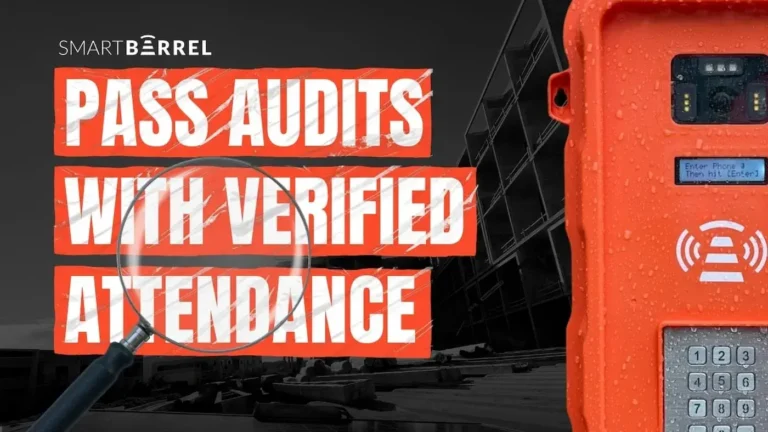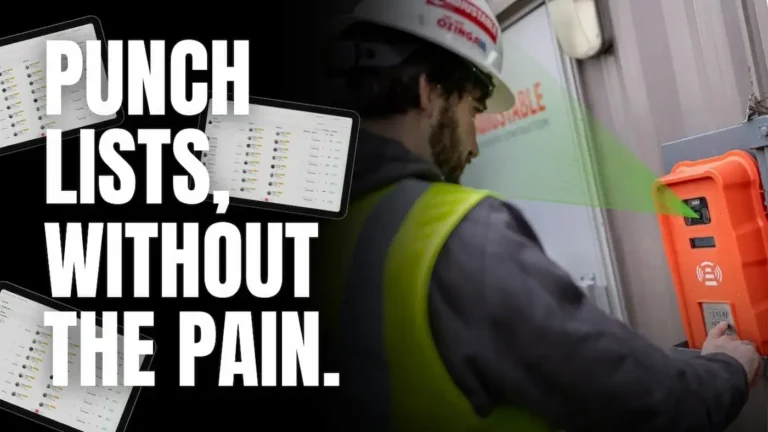To ensure a project’s success, it’s important to monitor its financial health relative to its progress. Throughout the project’s life cycle, several expenses must be accounted for, including materials, equipment, and worker pay. A work in progress report for construction helps you keep track of a project’s budget in comparison to its timeline.
Here’s what you need to know about WIP reports, and how the SmartBarrel device can help you track important information for more efficient management.
What is a WIP report in construction?
A WIP report allows contractors to determine whether they’ve overcharged or undercharged for a current job.
While overbilling a project may seem like a good idea, it has the potential to cause profit erosion or funds mismanagement. More often than not, it results in job borrows (i.e., negative cash flows due to exceeding how much can be billed for the project).
On the other hand, underbilling can prevent companies from receiving profit upon completion. In fact, it often means firms will have to self-fund parts of the project.
WIP reports allow you to determine whether you’ve billed more than or less than the project’s completion percentage. For instance, if you determine that you’ve charged 30% for a project that has been completed by 50%, you’ve underbilled.
These kinds of reports are important for staying ahead of projects and ensuring that they’re in good health, given the impact of overbilling or underbilling.
Both project managers and accounting can use these reports to assess how a job is moving along, come to an understanding over concerns, and identify and monitor any red flags before they have an impact.
Why should you use a work in progress report?
Other than the fact that a WIP report is often required for construction projects, it’s useful for the following:
- Giving clear insight into the current position of a job
- Allowing shareholders to actively monitor cash flow
- Helping to determine the right amount of tax to pay based on calculated revenue
- Providing an accurate picture of the firm’s financial position
- Ensuring accurate finances to prevent exaggerating revenue
- Allowing companies to accurately predict the future in terms of finance
Preparing WIP reports
To put a WIP report together, you’ll need information including:
- The amount charged for the contract
- The estimated cost for completing the project
- Costs to date
- Billed revenue
- The percentage of the project completed
- Underbillings
Reports are compiled by project managers, who can make use of advanced technological tools like the SmartBarrel device with manpower tracking to determine important information, such as the number of hours a laborer has worked on the job.
Challenges with Creating WIP Reports
While WIP reports can be highly helpful for project and budget planning, they come with a number of challenges.
Challenge #1: Data Accuracy
Inaccurate data in the WIP report can lead to erroneous assessments of project status. This can result in costly delays. Factors that may contribute to this problem are:
- Manual data entry errors,
- Inconsistent data formats,
- Outdated information
- Lack of the right data processing tools
Solution: Implementing automated data collection and integration systems
You can take advantage of project management software that synchronizes real-time data from various sources. You can also consider establishing standardized data entry protocols and providing training for staff to minimize human error.
Even with all these solutions implemented, you still need to audit the data regularly in order to identify inaccuracies.
Challenge #2: Timeliness
Delays in data collection, report generation, and distribution can result in outdated information. This can reduce the report’s value for decision-making. Factors that contribute to these delays are:
- Complex approval processes
- Inefficient data-gathering methods
- Communication breakdowns
Solution: Streamline data collection and reporting processes.
You need to implement automated reporting tools that pull real-time data from integrated project management systems. Then, you must establish clear deadlines and responsibilities for data submission and report preparation.
Keep communication channels open among all stakeholders to address issues before they hurt the WIP report quality. Also, you have to regularly go back and review the report processes. You are likely to find inefficiencies that need to be dealt with.
Challenge #3: Consistency
Variations in reporting formats, data entry practices, and metric definitions across different projects and teams can lead to inconsistencies. These discrepancies make data analysis difficult and negatively affect the decision-making process.
At the same time, construction companies often use multiple software systems (e.g., project management, accounting, and scheduling tools). Integrating data from these disparate sources into a cohesive report can be complex.
Solution: Standardize the reporting process by developing uniform templates and guidelines
Start by defining clear metrics and key performance indicators (KPIs) that all teams must use. Provide training to help everyone understand and adhere to these standards.
Implement centralized project management software that enforces these templates and guidelines. Then take the time to review and update the standards to reflect the evolving project needs.
Challenge #4: Human Error
Mistakes in manual data entry, misinterpretation of data, and inconsistent reporting practices can lead to inaccuracies. These issues tend to snowball and compromise the reliability of the reports. As a result, you face flawed assessments of project progress and financial status.
Solution: Implement automated data entry and reporting systems
You can use project management software that integrates with other systems to pull accurate data directly into WIP reports. Make sure that all data entry processes are standardized and all team members know about the new approach.
Challenge #5: Project Complexity
In the construction industry, large projects often involve numerous tasks, multiple stakeholders, and various phases. This volume makes it difficult to compile comprehensive reports. It can also interfere with accuracy and consistency.
Solution: Break down the project into manageable segments and assign dedicated teams to monitor each segment’s progress.
You need advanced project management software and relevant hardware that allows for detailed tracking and reporting of every aspect of the project. Teach your teams to consistently update their progress in real-time. This will provide a holistic overview of the entire project.
To ensure accuracy, conduct regular meetings to synchronize updates and address potential discrepancies.
Challenge #6: Interpretation of Data
Misunderstanding the data can lead to incorrect assumptions about project status, resource allocation, and financial health. This can cause you to make misguided decisions and lead to project delays. As a result, you are likely to face additional construction costs that negate all the benefits of implementing WIP reports.
Solution: Provide comprehensive training for staff on data analysis and interpretation
You can use data visualization tools (charts, graphs) to present complex data in an easily digestible format. Establish clear guidelines for data interpretation for work-in-progress reports to ensure consistency across the organization.
You can also arrange regular review meetings where team members can discuss findings and interpretations. These efforts have the potential to foster a deeper understanding and reduce the risk of errors.
Challenge #7: Change Management
Changes in the scope, schedule, and budget of the project often make it challenging to keep WIP reports accurate. These changes can result in discrepancies between the planned and actual progress and complicate the tracking and reporting process. Failing to reflect these changes promptly can lead to poor decision-making.
Solution: Implement a robust change management process
Take advantage of project management software that integrates change tracking features so you can create real-time updates to WIP reports. If possible, assign a dedicated change manager to oversee the process.
Make sure to conduct regular review meetings to discuss changes and their impact on the project. The goal is to keep everyone on the same page and ensure timely adjustments.
Managing and using a WIP report
WIP reports are managed and used by operation managers and accountants. Since an accurate WIP is needed to properly oversee a project and can have a monumental impact on a construction firm’s revenue, collaboration is necessary, with several things to keep in mind.
Project managers and other stakeholders should organize meetings periodically to examine the project and adjust the work in progress schedule for construction.
During these meetings, all necessary details should be examined and thoroughly reviewed, including the actual cost for operation and the currently available budget. Being realistic can eliminate the likelihood of contingencies cropping up in the middle of construction.
Examine side-by-side expense calculations and the percentage of the job completed to check for any substantial discrepancies. Ensure that underbilling and delays are being accounted for.
It helps to take a forward-looking approach to project completion. Every activity that could facilitate or impede project completion must be carefully examined, with project managers then drafting a corrective budget. This helps with determining the amount required to complete the project.
Manage your project’s finances better with SmartBarrel
Due to the complexity of construction projects, completing one on time and within budget is not an easy task. However, the right team and accurate WIP reports can help facilitate completion and keep profit margins stable. To streamline project completion, consider also making use of technological solutions.
The SmartBarrel device is a plug-and-play box that’s magnetic, solar-powered, weatherproof, and LTE-connected. Built to withstand the rugged conditions of construction, it’s suited for all job sites, from small residential projects to larger commercial mega projects. And since it’s self-sustained, you won’t need any advanced infrastructure for setup, nor any IT department for maintenance.
Cost tracking
With cost tracking, you can easily monitor labor costs. You can set up, sync, and manage cost codes while splitting shifts across multiple construction phases. Report on hours by phase for better management, with the ability to oversee phases, occupation, and wages to be paid, all at your fingertips.
Get access to meaningful analytics, with accurate data from the field that you can trust. Insights are easy to understand—no need to manipulate data in Excel. You’ll get automated insights that are accessible and easy to follow, saving you time and money.
Plus, all payroll, cost tracking, and phase tracking information is centralized in one location, accessible at the drop of a hat, so you’ll never have to shuffle through file stacks again. It’s job cost tracking made simple.
More comfortable with your current accounting solution? No problem! While automating tasks, tracking productivity, and budgeting, you can feed the data collected by the device directly into your existing accounting ERP solution. Make your job more efficient by integrating the device with your ERP platform or project management software.
Manpower tracking
The SmartBarrel device’s manpower tracking features show all workers present on site. Workers simply check-in through an easy-to-use and verified process with biometric facial recognition for headache-free, fraud-free, and excuse-free attendance checks. Rest easy knowing you’ll be provided with accurate and verified data, reducing any possibility for confusion and fraud.
You can track in real-time who’s currently on-site, even when working remotely. Monitor your project at any time from anywhere with SmartBarrel’s intuitive dashboard.
Interested in improving your project’s operations? Want a better handle on your finances and WIP reports? Book a demo with SmartBarrel today!




